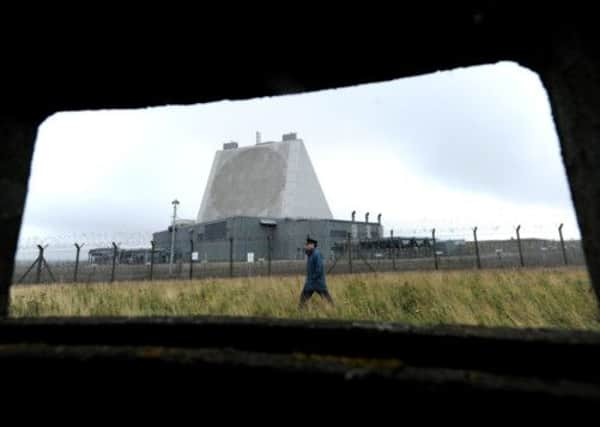Fylingdales marks first 50 years


But while history has evolved and the threat to national security has been transformed with the 9/11 terrorist strikes, the role of RAF Fylingdales continues to be as crucial as ever.
The iconic air base, standing 120ft high and situated 1,000ft above sea level between Pickering and Whitby, is marking 50 years of being one of the key strategic elements in the battle to contain the threat of missile strikes against the West.
Advertisement
Hide AdAdvertisement
Hide AdAs tensions mount with the possibility of a nuclear deployment from a number of countries, including Iran and North Korea, the radar station is playing an even more important role as a first line of defence against the unthinkable.
Station chief Wing Commander Rayna Owens said: “RAF Fylingdales has been a ballistic missile and early warning radar site since 1963 and is delighted to be celebrating its 50th anniversary. The importance of this mission endures and some would say is even more important.
“The UK consciousness of space and our reliance on it is growing as is that of the department. RAF Fylingdales is key to this growing understanding. Many staff have been living and working at RAF Fylingdales for over 20 years. This provides a unique perspective and a strong connection to our community. We are exceptionally proud of the work my team has put into this tribute to the last 50 years and we look forward to the next 50 years.”
Construction of the base began in 1960 and was cloaked in secrecy, with a procession of trucks winding its way across the moors while carrying equipment imported across the Atlantic from New Jersey. The cost of building the site was £45m – with the US contributing about £36m – and RAF Fylingdales became operational on September 17, 1963.
Advertisement
Hide AdAdvertisement
Hide AdThe base’s original radar system was housed in three “golf balls” which were each 84ft in diameter. The equipment was cumbersome but nonetheless extremely reliable – the mechanical radars were maintained for more than 28 years and were only out of action for 13 hours during that period.
But the need to modernise RAF Fylingdales had become apparent by the mid-1980s with an increasing number of satellites to monitor in the Earth’s orbit. The station now keeps check on more than 32,000 objects ranging from the International Space Station to a stray glove and screwdriver.
The UK and US governments announced an agreement on May 22, 1986, to carry out a £160m modernisation of the base, with the Americans paying £112m towards the overall cost. Up to 350 contractors built the Solid State Phased Array Radar – known by the acronym SSPAR – which is now housed in the famous three-sided building that has been afforded nicknames including The Temple of Doom, The Cheese Grater and The Sand Castle.
While the air base, which has a 350-strong workforce including a single US officer stationed there to ensure the necessary protocols are followed, conducts a relentless vigil for the possibility of a missile attack on the West, it has to deal with only a handful of actual incidents each year.
Advertisement
Hide AdAdvertisement
Hide AdThe radar provides coverage via a grid network which predicts the passage of satellites in orbit. If an unidentified object cannot be accounted for, the base is scrambled for what is simply known as a “missile event”. Instances are rare and number on average only about half a dozen each year, and the checks take less than 60 seconds – meaning the much publicised four-minute warning is a misnomer.
But despite the official line that the RAF station has a purely defensive role, it has been the focus of protests throughout the decades. Among the most high-profile critics has been the singer of Radiohead, Thom Yorke, who led a demonstration at the base in 2004 when he claimed the Star Wars programme to defend the US from missile strikes, to which RAF Fylingdales is intrinsically linked, is an “absolutely terrifying legacy”.